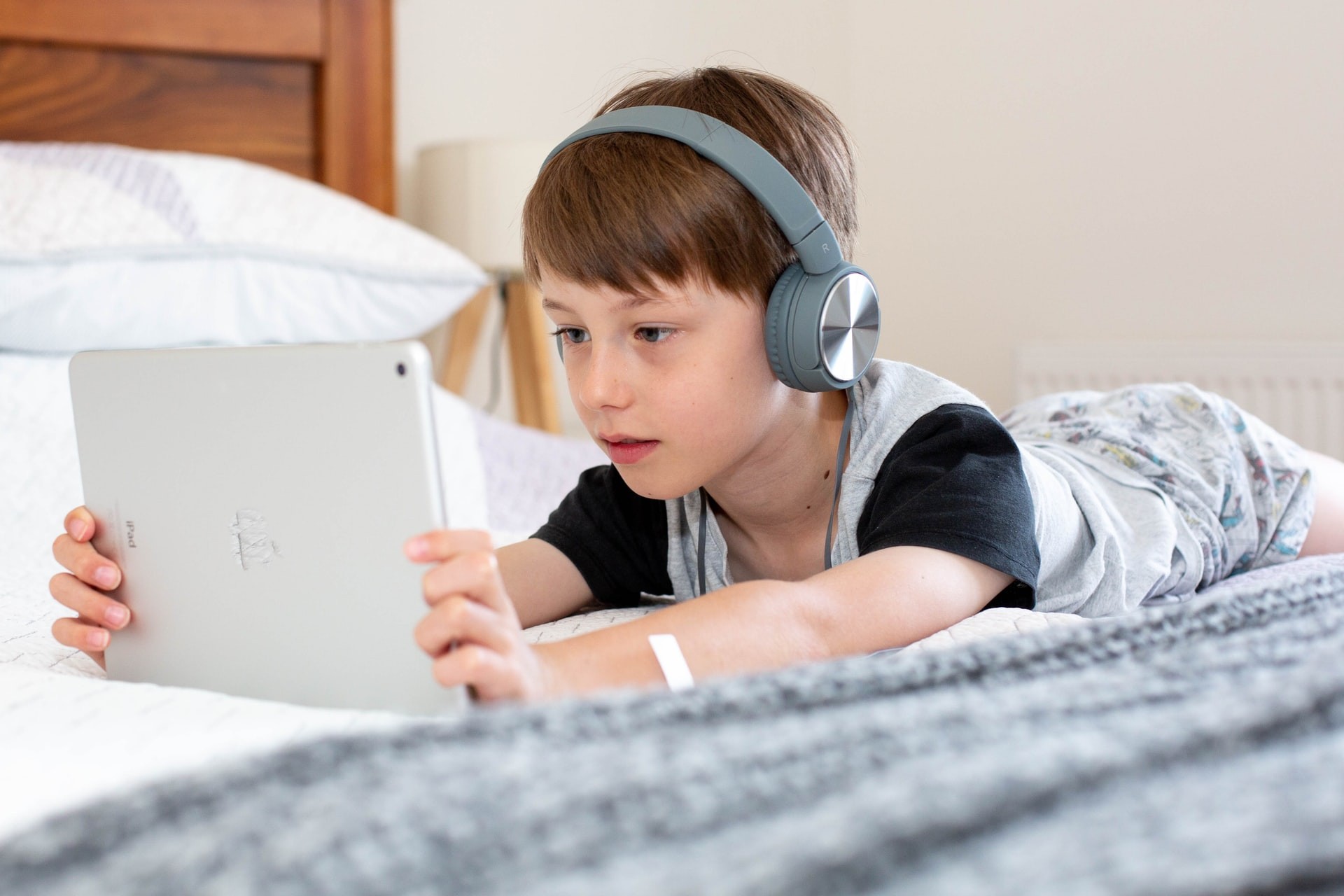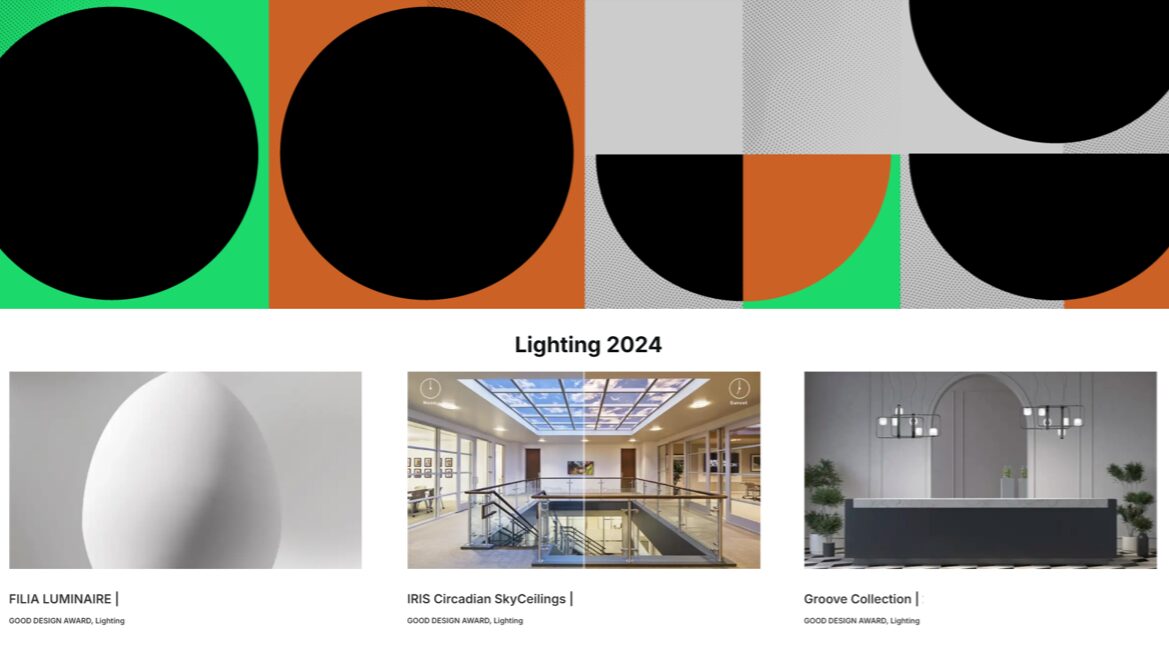One of the hardest jobs facing parents and nurses is talking to a child about complex (or simple) scary sounding procedures. Doctors often need to walk children through diagnostic tests that may involve discomfort, trigger separation anxiety, or cause emotional distress simply by virtue of the intimidating equipment or unfamiliar environment.
Of further concern, Research shows that anxiety in children before surgery can cause long-term psychological distress and behavioral issues, as well as increase the odds for a more painful recovery.1 In perioperative situations alone (perioperative means ‘around the time of surgery’ which includes everything from ward admission to recovery) about one in three pediatric patients (30%) resist receiving anesthetics.
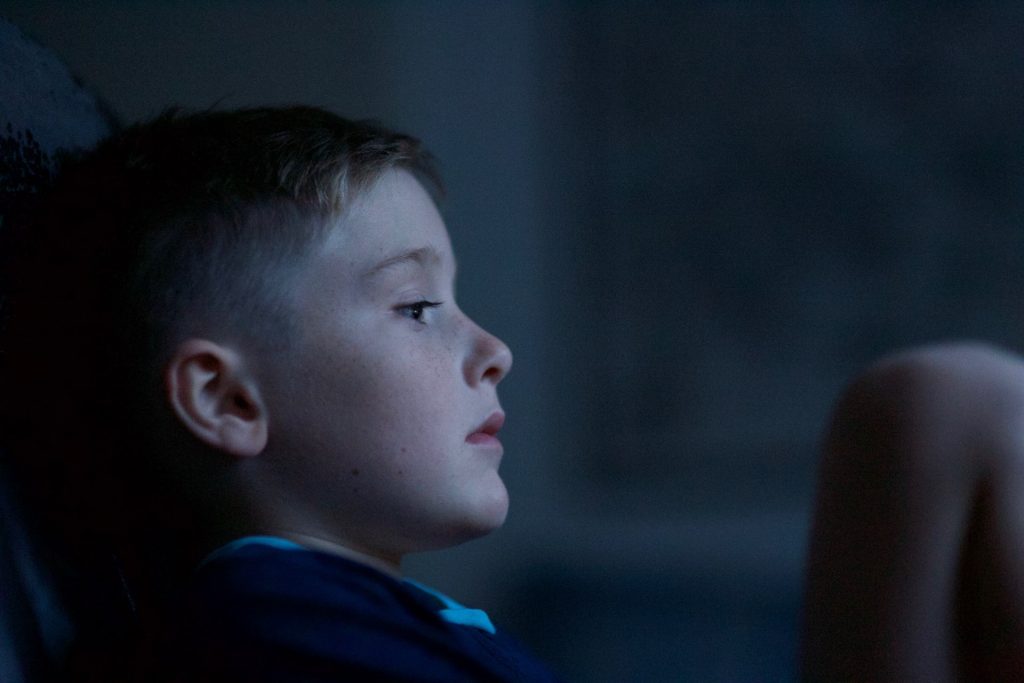
Stanford Medicine also notes that during induction of anesthesia 40% of children show visible signs of distress and another 17% show significant distress. Taken together, these figures indicate that the overwhelming majority of children (87%) experience persistent anguish as they undergo preparation for surgery.2
In order to mitigate patient distress, nurses know positive distraction techniques can often work wonders with anxious or uncooperative patients. Along these lines, the ubiquity of smart devices has given pediatricians the ability to explore immersive distraction technologies that can remove the patient’s attention, partially (or entirely) from their surroundings and thereby act as novel tools to reduce distress.
Part I –Tuning Out—Lights, Camera, Action!
The new pediatric distraction technologies are mobile, interactive, and their immersive attributes can displace the real environment with the computer-generated video projection systems of Augmented Reality (AR) or Virtual Reality (VR). Further, the immersive continuum offers degrees of visual distraction. While Augmented Reality superimposes digital graphics on a child’s real view of the world, thereby allowing for a hybrid experience, Virtual Reality devices remove a patient’s attention entirely from the surroundings and what might take place around their bodies.
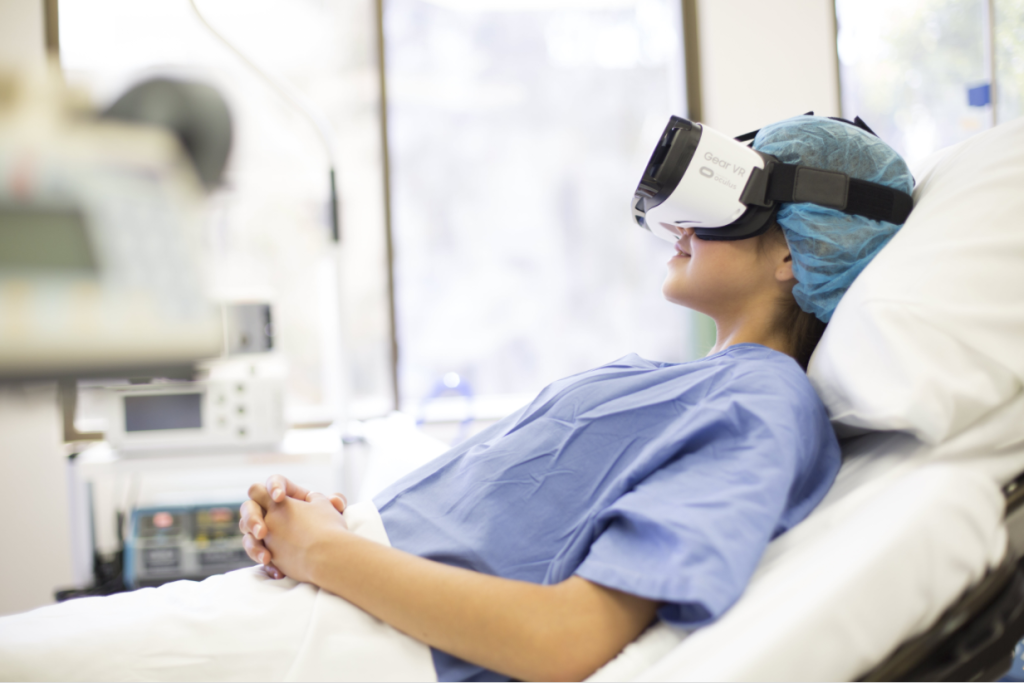
All these devices and their malleable capabilities have captured the imagination of doctors. At Lucile Packard Children’s Hospital at Stanford University, in Palo Alto, CA, a team of doctors is leading the way by exploring the spectrum of immersivity through its pioneering CHARIOT program—Childhood Anxiety Reduction through Innovation & Technology.
In his presentation, Non-Pharmacology and the Art of Induction (2018), Dr. Sam Rodriguez, co-director of the Stanford’s program, noted that his goals for the program were: first, to increase the safety of his patients through innovative evidence-based care; second, to raise the comfort of patients by minimizing pain and anxiety; and third, to ensure the long-term success of their health outcomes.
Trained as a pediatric anesthesiologist, Dr. Rodriguez and his fellow co-founder, Dr. Thomas Caruso, saw technology-based distractions as a possible way to minimize or altogether avoid the neurotoxicity of the anesthetics or the anti-anxiety medications often needed to sedate children before medical procedures. If his team can distract a child with an enticing video game instead of having to sedate them, that’s a winning scenario. Other times, anesthetic agents are still needed, yet, even then, gaining the child’s cooperation is crucial to a successful procedure.
Stanford’s pioneering program tapped Silicon Valley’s expertise to adapt existing VR technologies and tailor their cognitive load to facilitate a medical procedure (cognitive load is a measure of how much of the child’s attention is sequestered by a particular stimulus). In this manner, by using faster music, more colors, or increased game play, clinicians may be able to “maximize distraction efforts before and during minor medical procedures such as IV placement, wound care, and cast or surgical pin removal”.3
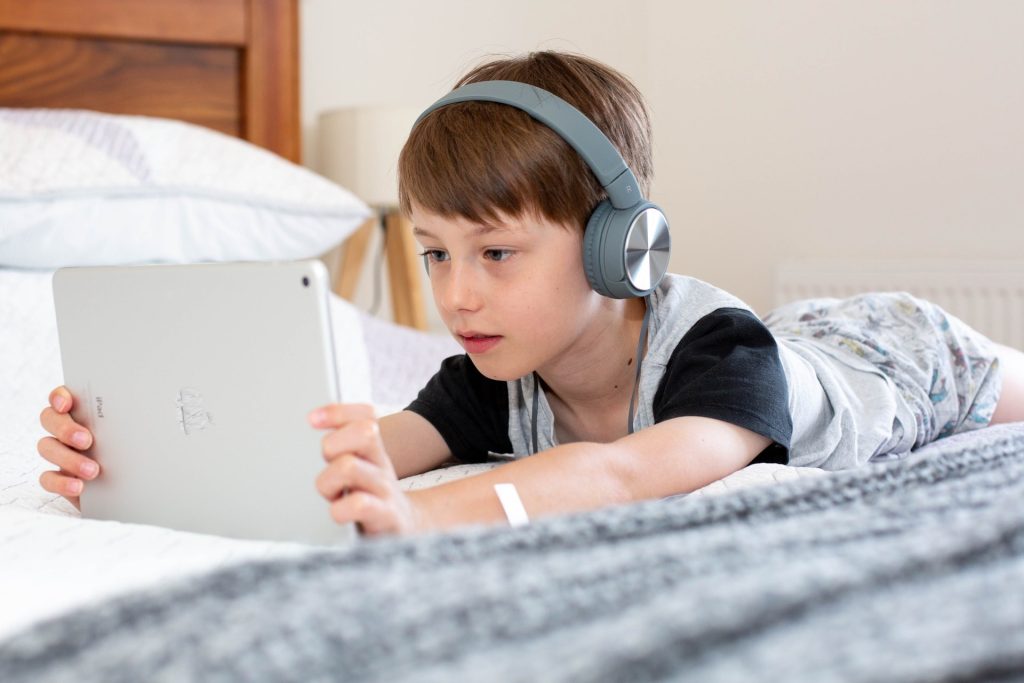
At the same time, Dr. Rodriguez, a Clinical Associate Professor in Anesthesiology, Perioperative and Pain Medicine at Lucile Packard Children’s Hospital, is the first to acknowledge that distraction techniques or technology without a caring and resourceful caregiver will not get most children through difficult or challenging procedures. And he definitely doesn’t think that immersive technologies should be embraced with a one size fits all mentality.
He notes that in trying out the latest positive distraction technology, pediatricians should be alert to identify three critical factors:
- Caregivers should realize that a suite of distraction tools is necessary to address different personalities, ages, and clinical situations.
- Pediatricians should realize that a patient’s attention is a limited resource. Therefore, distraction techniques must improve the patient experience, reduce stress, treat or reduce pain, not just remove them from the scene.
- Doctors and nurses should recognize that sometimes the best distraction technique is not technology, but a humane approach. Building rapport by asking questions, telling stories, even cracking a few jokes can accomplish much more than a video game with a frightened child and their parents.
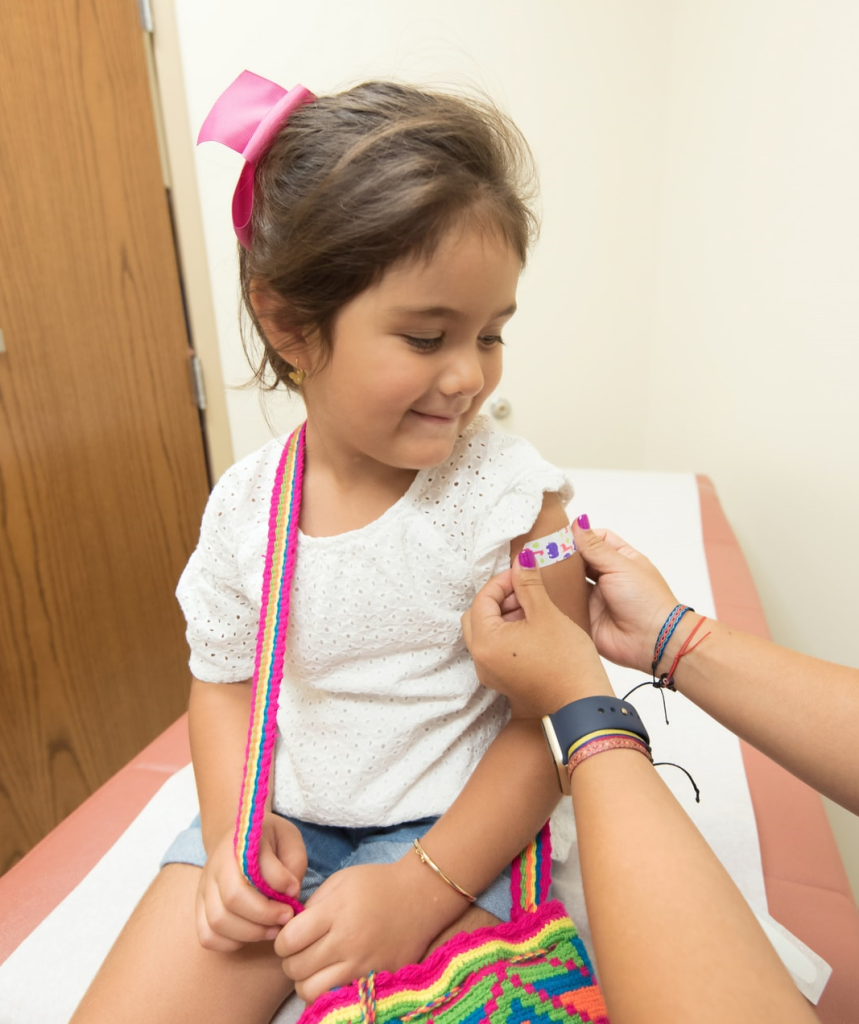
In the project, the Stanford team has found a huge response range to immersive technology. “Some kids don’t want to be immersed,” says Dr. Rodriguez. “They still want to be able to see their parents or observe the procedure while other kids don’t want to have any idea what’s going on. And for each kid it may vary based on the clinical scenario and what they’re going through at that time.”4
“The overall goal of immersing kids in a story, a movie, or a videogame is to grab their attention, so that it’s not focusing on something that is stressful, scary or painful,” he notes. Overtime, the CHARIOT program has identified three key patient groups. “Among our patients, there is a subgroup who do well during the procedure with or without VR; a [second] subgroup with minor anxiety where VR helps slightly; and a [third] subgroup where it makes a profound difference,” Rodriguez explains.5
The CHARIOT program was designed to help those suffering the most anxiety. However, the emphasis on smart technologies has also raised questions about alternate approaches to mitigate pediatric distress that don’t rely on expensive AR/VR equipment, burden a hospital’s Wi-Fi capabilities or add another category of patient care equipment to track, store, and disinfect prior to patient assignation.
Part II – Tuning In—Cultivating the Gentler Side of Attention
One of the biggest takeaways from the use of immersive distraction technologies is the learned behavior they encourage. This is a very important consideration given the neuroplasticity of a child’s brain. Immersive technologies remove young patients from the surroundings by flooding their attention with an assortment of virtual characters, games and emotions. Hence, children are encouraged to divide attention when distressed, a distinct behavioral tendency that is more likely to be hardwired and remembered.
This distraction approach also presumes that children require heightened diversionary activity to remove them from the environment of care and counteract the stress and anxiety caused by medical interventions. This approach all but acknowledges that the environment of care itself lacks the architectural features that would enable both the caregiver and their patients to share a restorative and meaningful space together.
“It is not surprising that pediatric medicine has focused so much on distraction which feeds the naturally dynamic mind of children with ever more activity,” says Bill Witherspoon, Sky Factory founder and Creative Director. “What does surprise me a bit is that there seems to be a notion that children cannot reflect on or are not attracted to an experience of quietness, calmness, and peacefulness.”

“Caregivers would do well to remember that Nature displays tremendous activity while at a deeper level, such activity betrays a profound stillness. Rest and activity are twin faces of Nature’s universal rhythms that yield therapeutic value, particularly through biophilic design applications in healthcare environments,” says Witherspoon.
“Most media are designed to keep the awareness of the observer engaged in relatively superficial activity and hence tends to be one dimensional. However, experiencing the richness of nature—for example, observing the cloud patterns under a wide blue sky or following the shimmering shoreline through a window view—emerge from, and are embedded in, nature’s universal silence, its underlying stillness and rich atmospheric calm. Most importantly, in healthcare environments, these experiences correlate with a calm and stable physiology” Witherspoon underscores.
In fact, the calm and stable psycho-physiology that natural environments facilitate is highly desirable in times of distress because it assists in emotional bonding between patient and caregiver. In order to understand this shared experience, we must first explore why exposure to nature is fundamental in a child’s development and how its behavioral lessons can be leveraged in clinical settings.
Nowadays, studies note that the average American child spends less than 10 minutes a day of unstructured outdoor play versus +7 hours a day in front of a screen, whether it’s a television, a computer, or a smart device. Richard Louv, best-selling author of Last Child in the Woods and Saving our Children from Nature-deficit Disorder, has long underscored how the diminishing exposure that children in high-tech nations have to nature negatively impacts their immunity, creative powers, and self-confidence.

A number of developmental psychology studies have shown that one of the healthiest activities for a child is spending significant time in unstructured play, particularly in nature. By exploring and investigating natural environments children develop a range of valuable life-long behaviors, including exercising the gentler side of attention: self-awareness and situational awareness.

Sky Factory’s Open Sky Compositions feature birds in flight or hidden in foliage, enabling caregivers to engage children about their experience observing animal patterns and behavior.
By learning to observe roving insects, wild animals, plant life, or moving water, clouds and changing seasons, kids sharpen their ability to recognize patterns of behavior, cyclical phenomena, and develop either empathy or respect for creatures large and small. The skills honed during unstructured outdoor play yield a range of cognitive benefits that enable kids to deal with life’s various challenges and stress in a constructive way. Nature’s scenic patterns and spatial relationships also encourage careful observation, daydreaming, and the quiet introspection of emotions and memories. These self-directed behaviors can also be facilitated in interiors with a meaningful visual connection to nature.
Unstructured outdoor play and carefree reminiscing foster self-direction, which is a fundamental skill for any child facing uncertainty or fear. Unlike computerized toys and video games which provide a clear set of rules and rewards, natural habitats offer a wealth of possibilities—a colorful rock quickly becomes a hike’s precious memento or a handy tool. And this ability to shape the narrative and move independently nurtures a child’s sense of agency, one that becomes invaluable when facing adverse situations like landing in the doctor’s office or in the pre-op room.
In this context, exposure to nature is multi-sensory, providing a deep connection to our epigenetic memories of our ancestors’ survival in nature. This connection to life, best exemplified by the Biophilia Hypothesis—humankind’s innate attraction to and affinity with living systems—offers a much needed life line in the built environment. Unlike arbitrary digital plots and characters, nature’s patterns inform our own biology and entice curious eyes and minds. Therefore, allowing a child to observe and explore nature’s patterns in an unfamiliar environment will not only hold their attention, but also reduce their emotional distress and mental anguish.

The quiet observation and situational awareness habits nurtured by exposure to nature are psycho-physiological responses that entrain resilience when facing a medical challenge or frightening procedure at the hospital. Furthermore, when hospital environments are not designed to incorporate nature’s healing patterns and attributes, caretakers are unable to call upon the instinctive behaviors that allow a child to settle themselves down or to productively direct the child’s attention and imagination via recognizable and soothing environmental features.
This is why child psychologists recognize the importance of nurturing self-regulation, a fundamental skill in building resilience. According to the Child Mind Institute, self-regulation is the ability of a child to manage their emotions and behavior according to the demands of the situation. As a child matures, it is important that they are able to adapt their behavior despite overstimulation or unsettling stimuli.
Dr. Matthew Rouse, a child psychologist, notes that emotional control in children emerges from a combination of innate temperament and learned behavior. “A child’s innate capacities for self-regulation are temperament and personality-based.” He explains that babies and toddlers who are easily distressed or who had trouble self-soothing may experience trouble self-regulating their emotions as they grow and confront childhood challenges—like a visit to the doctor, taking an unpleasant medicine, or having to deal with a blood test or an MRI scanner.
If kids learn to become overly dependent on smart devices as external self-regulators, the learned behavior could become a hard habit to break later in life. Self-regulation becomes an outsourced condition rather than one that involves self-awareness, behavioral modulation and ultimately, emotional resilience.
Part III – Biophilic Design in Pediatric Care
Forty years of Biophilia research documenting the psycho-physiological benefits of humankind’s exposure to nature has enabled a new generation of designers to bring in or mimic the attributes of natural environments in the built environment. When healthcare interiors feature nature’s pre-eminent healing attributes like natural daylight and views to open skies or green spaces, patients relax. Healthcare designers have sought to bring these restorative attributes to pediatric settings with a playful twist.
Healthcare designers apply robust biophilic design principles to significantly reduce patient anxiety, enhance mental acuity, and balance frayed emotions. In pediatric settings, by drawing on environmental features that children recognize as both familiar and engrossing, medical staff can direct their attention in a way that they feel connected to the situation. At the same time, a child’s imagination, once engaged, takes comfort in times and memories spent playing outdoors—in nature, discovering their ability to master their initial apprehension, which at first seemed unsurmountable.
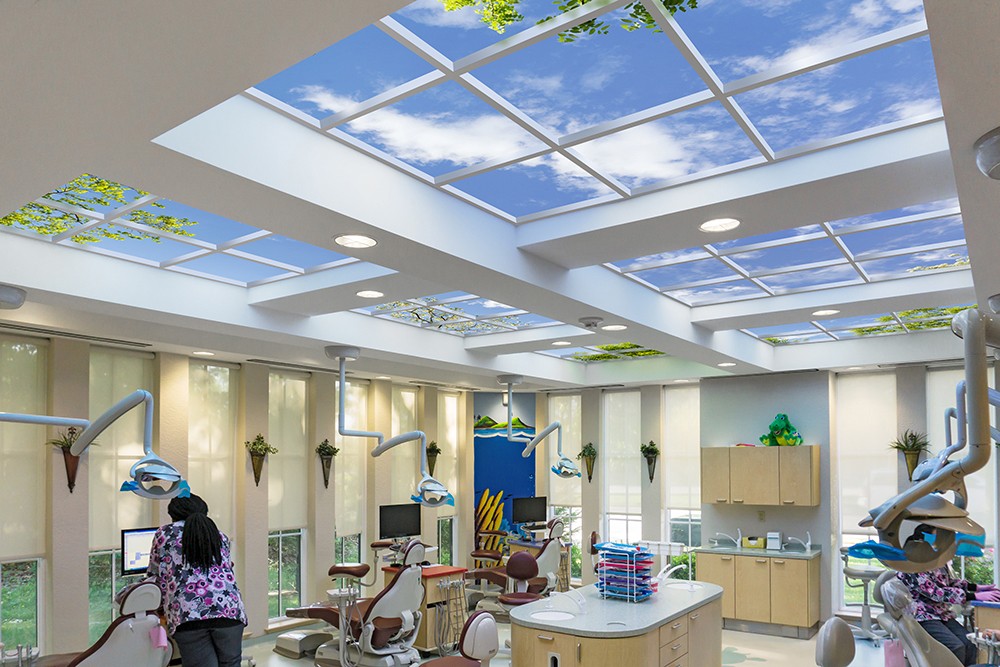
When a child harnesses their ability to see their body and surroundings as part of a meaningful biophilic connection to a natural open space, they gain a sense of agency over the unfamiliar atmosphere of clinical settings. And having thus honed their powers of attention by focusing on sensory stimuli that is dynamic, yet soothing also stimulates memories that prove to be beneficial in the long run. Such biophilic representations of nature also create opportunities to establish rapport between patient and caregivers by relating stories about the outdoors, engaging the child and their family with questions about favorite animals and memorable nature outings.
Furthermore, it is vital to emphasize that the most immersive technology is a child’s own imagination. Once engaged, their mind can generate a wonderful inner environment that impacts how they feel about their surroundings. In this context, digital technology can be leveraged to mimic natural environments, thereby enlivening an affective bond between past experience and present circumstances.
For example, Sky Factory’s Digital Cinema line includes a gallery-quality virtual aquarium (eSea) that is designed as a window into vivid underwater environments. Heraclitean Motion—the familiar, yet random movement of nature’s cyclical motions, including the fluid motion of sea life—has been verified by multiple studies to reduce stress and anxiety, even pain perception, in patients exposed to aquarium windows before a medical procedure.
The gentle gliding of fish large and small, including the to-and-fro sway of coral reefs and algae forests provide a soothing and deeply therapeutic experience in otherwise artificial healthcare interiors. eSea’s Virtual Aquarium views are unedited, feature-length scenes of exotic underwater environments. Unlike other digital presentations that offer cartoon characters that children can manipulate through touch screens to alter their color and characteristics, eSea nudges children to observe other life forms, learn from their behavior, and experience the soothing nature of such engagements.
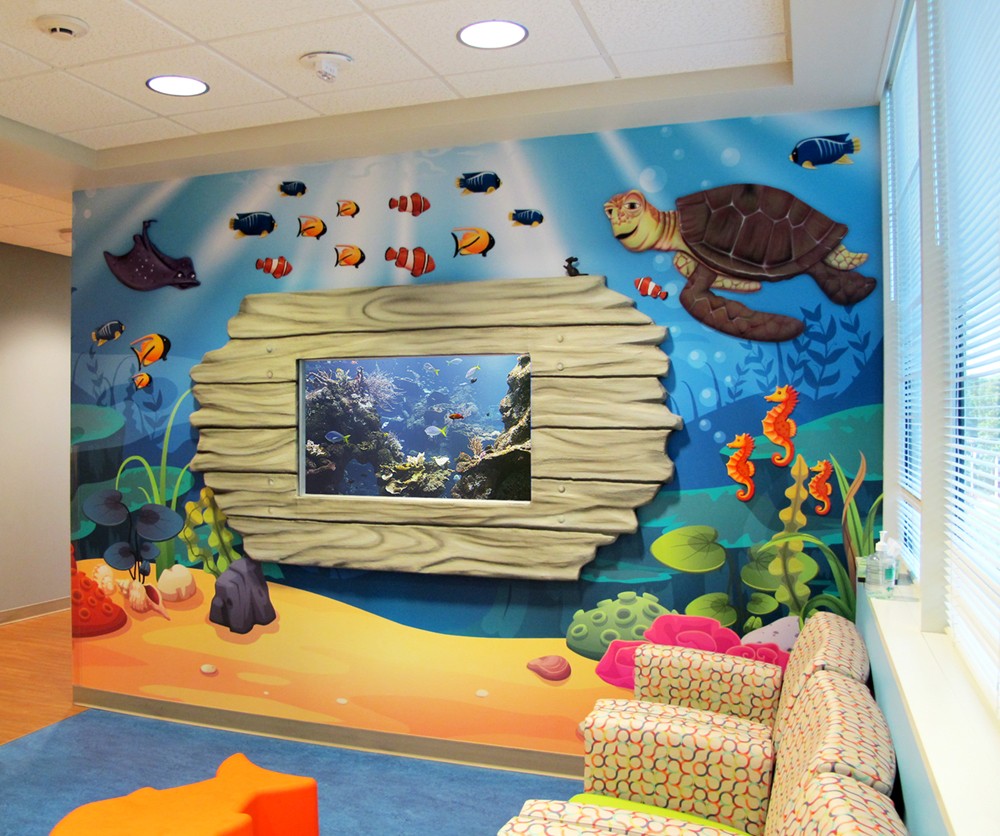
In contrast, more activity-laden distraction techniques reinforce a feedback loop—the more active and diverted the child’s attention becomes when facing distress, fear, or anxiety—the more such evasive behavior becomes an ingrained or learned response. The child loses an opportunity to receive and recognize the support and empathy of others involved in their care or incorporate his surroundings into the present situation.
The trials and tribulations of childhood are also the early tests that inform our brain’s plastic connectivity and forge our personalities as we mature into teens and young adults. Learning how to step back and gain emotional balance under duress yields lasting resilience. And given that self-regulation is a life-long skill, it’s an invaluable skill set to exercise. Experiencing fear and anxiety may start in childhood, but the self-confidence to navigate such emotions takes both courage and practice.
Part IV – Biophilic Illusions of NatureTM
Sky Factory’s biophilic illusions of natureTM are designed to generate the visceral impression that the sky’s healing vastness is readily accessible. By taking into account the masterly principles of painterly composition, plus incorporating about 20+ structural and contextual cues to high resolution images of overhead skies, skilled visual artists and craftspeople can design credible spatial illusions.
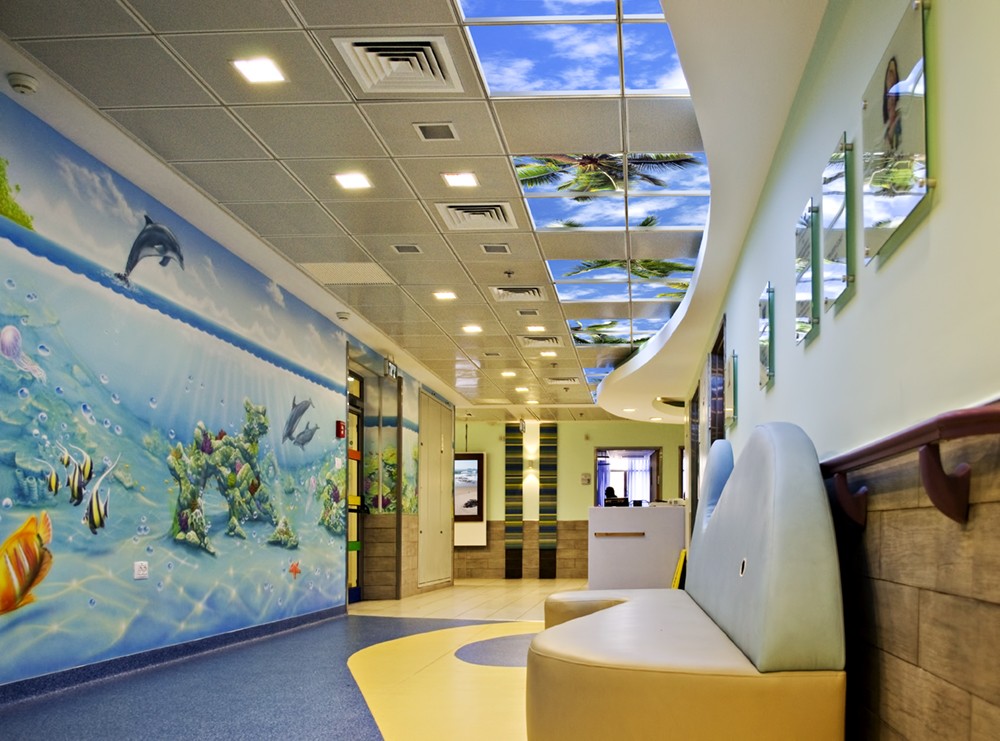
At Yoseftal Medical Center in southern Israel the pediatrics department sought to open up the reception area and main hallway. “We wanted to create the outdoors feeling of a beach in the interior playroom space, and thanks to Sky Factory’s Luminous SkyCeilings we were able to bring the optimistic view of the sky,” says Michael Rom, the project’s lead architect. The illusory blue sky overhead and the shoreline mural invites children to play as the area gained an inviting openness.
Trained to capture, compose, and stage gravitationally correct sky imagery (sky vistas depicting a point-of-view perpendicular to the ground) in windowless, isolated, or highly artificial healthcare interiors, Sky Factory artists and engineers enlist our hardwired habits of perception to create palpable illusions of vertical volume.
Environmental psychology studies have shown that humans perceive an asymmetrical relationship between time and space where the amount of space around our bodies tends to impact the observer’s subjective assessment of time. This is why vacations spent outdoors, in nature, facilitate abstract thinking—we reminisce, process memories and pent up emotions, creative ideas flow, and people even report feeling more attuned to the spiritual and intuitive dimensions of life.
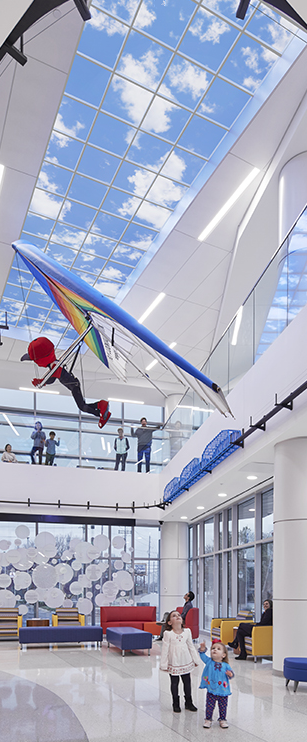
While an adult’s intellect knows that these skies are illusory, the physiology’s gut response is automatic—we relax. In younger kids, the unexpected views spark their curiosity. “We have a Luminous SkyCeiling with clouds and blossoming trees in the examination room,” says Dr. Adrianne Cruz at Marshfield Children’s Hospital, in Marshfield, Wisconsin. “Many preschoolers ask me if it’s a real skylight whereas many teenagers just want one at home.”
“The SkyCeiling provides an excellent, visually calming distraction during potentially difficult examinations,” says Dr. Cruz. “I even found an unexpected benefit of using it as a lighting source in the room during eye exams and for patients with migraines.” Clear lines of sight to a natural open sky allow patients to decompress. Perceived proximity to the sky, even if illusory, is potent medicine.
The unique geometry of design found in Sky Factory’s research-verified SkyCeilings provide a highly therapeutic environmental tool for caregivers that works in two ways. First, the Open Sky Compositions immediately become part of the child’s perceived sense of place, allowing caregivers to build an emotional bond with the child in a meaningful way. Second, the installations provide as much of a needed respite for weary healthcare staff as for the little patients they meet in these spaces every day.
“While they may articulate their experience differently, I believe that children are at least as capable of registering the full dimensionality of nature as are grown-ups,” highlights Witherspoon. “It may be that we’re simply not giving kids the opportunity to recognize that silence within or recognizing it around themselves while engaged in the simple act of observing or being attuned to their surroundings,” he adds.
Bereft of natural environments, the opportunity to observe and relate to others is often missing in healthcare settings . However, even these under designed spaces can offer the opportunity to generate biophilic illusions of nature that can entice our hardwired habits of perception. In fact, neuroscientists have discovered that many of the same cortical regions engaged when we observe an object, such as a pear or the foliage outside a window, are also engaged when we imagine or recall that same object or scene from memory.
The neural links between what we see and what we imagine, which may appear to separate what is real from the imagined, leverage the same cognitive mechanisms. Hence, a bi-sensory (visual and spatial) illusory sky is able to engage the same areas of the brain as those involved in our past experiences under the sky, thereby yielding a powerful autonomic Relaxation Response.
And what is an engrossing sky view but our most universal experience of relief?
All in all, pediatric care is not just about mending bodies, but teaching young spirits endurance in times of strife for the road of life is long and uncertain.
“Come forth into the light of things, let nature be your teacher.” – William Wordsworth
References
1 Jenny Gold. “Doctors Get Creative to Soothe Tech-Savvy Kids before Surgery.” Retrieved on Mar. 10, 2022 from: https://www.npr.org/sections/health-shots/2016/06/29/483056065/doctors-get-creative-to-soothe-tech-savvy-kids-before-surgery
2 Dr. Sam Rodriguez, Lucile Packard Children’s Hospital. “Non-Pharmacology and the Art of Induction.” Retrieved on Mar. 3, 2022 from: https://vimeo.com/303742025
3 Stanford Children’s Health. “Stanford Children’s Health establishes one of the nation’s largest VR programs tailored for pediatric care, helping to ease pain and anxiety in more kids.” Retrieved on Mar. 10, 2022 from: https://www.stanfordchildrens.org/en/innovation/chariot/national-leader-in-scaling-vr
4 Stanford Children’s Health. “Hospital-wide access to VR alleviates pain and anxiety for pediatric patients.” Retrieved on Mar. 11, 2022 from: https://www.stanfordchildrens.org/en/about/news/releases/2017/virtual-reality-alleviates-pain-anxiety

